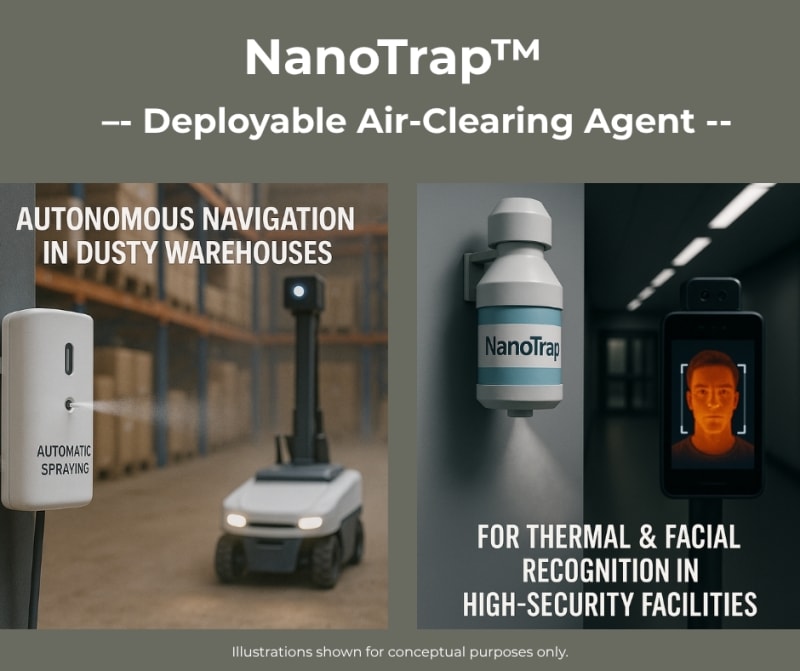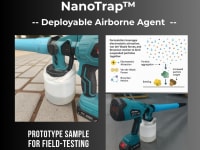NanoTrap™ is a deployable, airborne particulate-binding agent designed to improve sensor accuracy in Industrial Internet of Things (IIoT) environments. Unlike traditional filtration or ventilation systems, NanoTrap™ does not require power, fans, filters, or structural integration. It is applied as a fine mist directly into the surrounding air, where it passively captures airborne pollutants such as PM2.5, PM1.0, and nanoscale aerosols that interfere with sensor performance.
The formulation consists of engineered molecules that leverage electrostatic attraction, van der Waals forces, and Brownian motion to bind suspended particles together. These interactions cause particulates to aggregate, gain weight, and settle more rapidly onto surfaces, reducing the concentration of pollutants in the airspace immediately surrounding sensitive components. This enables sensors—especially those measuring air quality, gases, or optics—to maintain data accuracy even in harsh, dusty, or high-interference conditions that would normally compromise sensor performance.
In a controlled simulation, NanoTrap™ was deployed in a sealed glass chamber saturated with incense smoke to simulate a high-PM environment. PM2.5 levels initially exceeded 1,000 µg/m³. Within 5 minutes of spraying, without any airflow or filtration, concentrations dropped to around 400 µg/m³—a passive reduction of over 60%. This result highlights NanoTrap™’s real-time effectiveness in enclosed sensor housings and confined field environments with limited ventilation.
NanoTrap™ is based on proprietary nano-scale carriers currently under IP filing by Doctor T Co., Ltd. It contains no carcinogenic substances such as formaldehyde, no heavy metals, and no corrosive or conductive components—making it safe for use near sensitive electronics. It is a single-component agent that is easy to apply without mixing, and it does not interfere with sensor hardware when used with proper directional deployment. The formulation is compatible with automated mist dispensers, and integrated IoT fogging systems—allowing seamless integration into both existing and next-generation IIoT environments. This streamlined composition and flexible delivery enable NanoTrap™ to be affordably scaled and widely adopted in mission-critical industrial and environmental applications.
Potential use cases include:
- Outdoor IIoT sensor stations in dusty industrial zones, roadside monitors, or construction areas
- Agricultural monitoring systems exposed to pollen, soil, and windblown particles
- Mobile air-quality sensing kits for disaster-response or wildfire events
- Enclosed test chambers, data collection labs, and cleanroom-adjacent environments
- Smart home IoT systems requiring passive PM suppression near sensitive sensors
What makes NanoTrap™ novel is its shift away from conventional boundary-based filtration toward ambient air correction. Instead of capturing particles at intake points, it reconditions the airspace where sensing occurs—effectively transforming the environment itself into a passive defense layer. This concept is particularly relevant in the context of IIoT, where distributed, low-power sensing nodes operate in environments lacking infrastructure for traditional air cleaning.
NanoTrap™ fills a critical gap in the expanding ecosystem of smart sensing: maintaining accuracy and longevity in the face of airborne interference. Lightweight, scalable, and rapidly deployable, it represents a new frontier in sensor resilience, environmental health, and intelligent infrastructure. In a future shaped by interconnected systems and autonomous sensing, NanoTrap™ offers a quiet but powerful foundation for cleaner data—and cleaner air.
Video
Like this entry?
-
About the Entrant
- Name:Voraya Jirawatcharakorn
- Type of entry:individual
- Software used for this entry:์Not Applicable
- Patent status:pending









